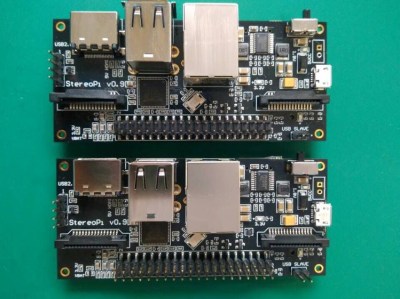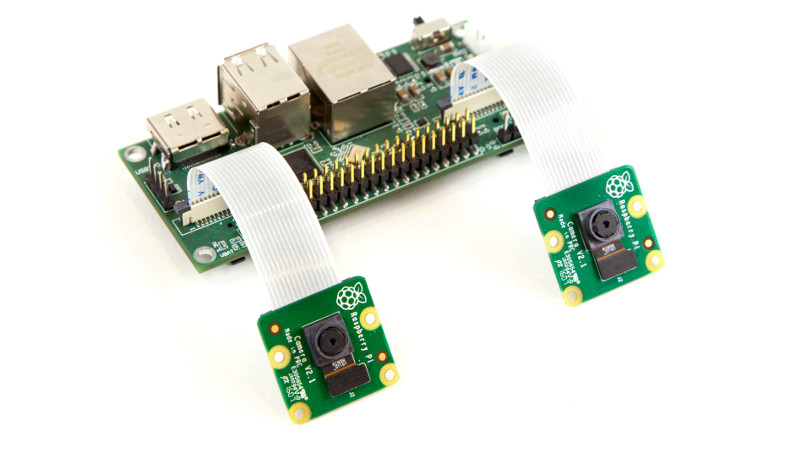Over the years we have featured a huge array of projects featuring the Raspberry Pi, but among them there is something that has been missing in all but a few examples. The Raspberry P Compute Module is the essentials of a Pi on a form factor close to that of a SODIMM module, and it is intended as a way to embed a Pi inside a commercial product. It’s refreshing then to see [Eugene]’s StereoPi project, a PCB that accepts a Compute Module and provides interfaces for two Raspberry Pi cameras.
What makes this board a bit special is that as well as the two camera connectors at the required spacing for stereophotography it also brings out all the interfaces you’d expect on a regular Pi, so there is the familiar 40-pin expansion header as well as USB and Ethernet ports. It has a few extras such as a pin-based power connector, and an on-off switch.
 Where are they going with this one? So far we’ve seen demonstrations of the rig used to create depth maps with ROS (Robot Operating System). But even more fun is seeing the 3rd-person-view rig shown in the video below. You strap on a backpack that holds the stereo camera above your head, then watch yourself through VR goggles. Essentially you become the video game. We’ve seen this demonstrated before and now it looks like it will be easy to give it a try yourself as StereoPi has announced they’re preparing to crowdfund.
Where are they going with this one? So far we’ve seen demonstrations of the rig used to create depth maps with ROS (Robot Operating System). But even more fun is seeing the 3rd-person-view rig shown in the video below. You strap on a backpack that holds the stereo camera above your head, then watch yourself through VR goggles. Essentially you become the video game. We’ve seen this demonstrated before and now it looks like it will be easy to give it a try yourself as StereoPi has announced they’re preparing to crowdfund.
So aside from the stereophotography why is this special? The answer comes in that it is as close as possible to a fresh interpretation of a Raspberry Pi board without being from the Pi Foundation themselves. The Pi processors are not available to third party manufacturers, so aside from the Odroid W (which was made in very limited numbers) we have never seen a significant alternative take on a compatible Raspberry Pi. The idea that this could be achieved through the Compute Module is one that we hope might be taken up by other designers, potentially opening a fresh avenue in the Raspberry Pi story.
The Raspberry Pi Compute Module has passed through two iterations since its launch in 2014, but probably due to the lower cost of a retail Raspberry Pi we haven’t seen it in many projects save for a few game consoles. If the advent of boards like this means we see more of it, that can be no bad thing.















I can’t find the schematic, so I’m still puzzled on one basic question: Obviously the SoC supports two cameras because most mobile phones have front and rear cameras, but don’t they have different numbers of pins? The Compute Module pinout shows CAM0 has a 2-lane and CAM1 has a 4-lane CSI interface.
Does this mean the cameras are running in asymmetric modes, or are they both being stepped down to 2-lane mode, or what?
All the official Raspberry Pi cameras only use 2 lanes. No ‘stepping down’ required.
I am using the Compute Module 1 with 2 cameras ( OV5647 sensors ). However, I am able to take pics from only cam0 port but not from cam1 port ass Raspberry Pi Camera Rev1.3 supports 2 lane and not 4 lane interface. So yea. I guess we need to perform some stepping down.
Checkout the Lindenis V5. It is a dev board based on the Allwinner V5. For about $100 (aliexpress) you can get dual 4K cameras with hardware binocular depth mapping.
It also has has a hardware Haar feature classifier.
https://en.wikipedia.org/wiki/Haar-like_feature
OpenCV support for the Haar classifier is supposed to be coming, meanwhile the SDK includes about a dozen prebuilt modules – faces, people, license plates, parking spaces, etc.
And, unlike the RaspPi CPU, you can actually buy the Allwinner V5 SOC for under $10. So you can make your own PCBs if you can handle BGAs and DDR3 memory.
SDK is on Github:
https://github.com/lindenis-org
I forgot the link to the board
http://www.lindeni.org/lindenis-v5.html
Details on HAAR classifier….
1.360p detection speed>30FPS (working frequency >300MHZ)
2. Support classic HAAR feature classifier detection, the number of
features up to 3200
3. Support maximum resolution 4K input and internal zoom to support
region of interest detection
4. Support 4-channel integral map calculation, processing 1.3 billion
features per second
5. Support 3-channel feature calculation
6. Support user-defined target size, support 432 different kinds of
detection frames
7. Supports minimum 64×64 pixel single image detection
8. Low power consumption, 360p full picture detection <57mw
9. Classifier visual design, providing a complete set of training,
debugging, testing and evaluation tools
10. Customizable classifiers to support arbitrary small deformation
rigid target detection (face, vehicle, license plate, pedestrian, etc)
Allwinner has not released the tool in #9 yet. But they are working on it and promise to release as soon as possible.
That is a remarkable amount of power and utility for a very modest price. Two 4K cameras will double your costs, but still the total is very acceptable.
I don’t get it. Why not put the processor on the board and do away with the connector and Raspberry Pi Compute? The Compute is just a breakout board.
From article:
> The Pi processors are not available to third party manufacturers
One word “Broadcom”, they sell solutions not chips, so unless you are using their services you can not.
I’m curious what the latency is like on this. I’ve got an OSVR headset that can accept a single HDMI input for the internal display, and I’m trying to determine whether it’d be better to use that plus a pricey FPGA, or something like this raspi board for a realtime third-person-view headset
The camera support should be attached to the head, not the back! The information received by the subject would be much more consistent.
Why would you ever want something like that? You’ve already got two cameras attached to your head.
Oh wait, I get what you mean now. My bad, I’m dumb. Might feel weird having a giant lever on the back of your head though, could be a pain in the neck after a few minutes!
Why is the Compute Module higher priced when with their larger PCBs and all the connectors the other Raspberry Pi versions (aside from the Zero) have to cost more to manufacture?
If they want more market penetration with the Compute Module, the price will have to be lowered. Having the other versions that require nothing but standard peripherals to use priced less skews customers’ perception of value of the product. Like if a car company charged more for a model without all the fancy luxury features.
The Pi is and always will be heavily subsidized to gateway you into Broadcom.
The compute module is available in quantity, whereas you can’t mass produce products based on the Pi.
Addendum, with cars stripped out, lightened sport models do sell for more.
I don’t believe it is subsidized, instead I think they sell them with zero profit.
The explanation I have heard is that the PI boards are priced at cost as a gift to students and hobbyists. The compute model is for products and so it carries normal profit margins.
It is pointless to try and design your own low cost hardware using the PI SOCs, Broadcom won’t do business with you unless you will order millions of chips. I would instead recommend the Allwinner based boards which are available from many source and in many cases are cheaper than the RaspPi. You can also buy the Allwinner chips and make your own PCBs.
They do sell cars that cost more to get less. Ask what the price different would be to get a car with out Air conditioning.
….using technology to have an out-of-body experience :-)
… or more https://en.wikipedia.org/wiki/God_helmet
Although your link is interesting, what I’m talking about is strictly a visual experience. Seeing one’s self in the third person has got to be something special, like taking the experience of seeing yourself in a mirror up a level. I suppose it would be like any third person video game where you are outside the character you are controlling but are restricted to a hovering view over them. …Zelda…Tomb Raider…etc.
….God Helmet, never heard of that. Based on the Wikipedia entry, it sounds trippy which comes as no surprise considering it was developed in the ’60s/’70s…peace!! man!! pass me some more of those shrooms.
Jokes aside, the God helmet seems to touch on matters of self within the brain, something we really do need to learn more about. People, especially among technology fans, love to think/fantasize about artificial intelligence as actually being an entity but there is very little concrete understanding of what makes the “self” inhabit the responsive hardware of the brain, yet alone how we would ever duplicate that relationship in silicon. ….new vistas to explore with lots of truth to discover along with lots of already established falsities. …Adventure!! :-)
How the camera feed gets turned into something, that the VR-headset can read?
Not enough camera connectors.
I looking for something like this with at least 4 camera ports for picams.
Hopefully someone will come up with a kickstarter for them.
BTW these cameras are not reliable over the long term.
Over 100 days you might end up v2l frame completition errors and the only way to “fix” it since the cams wont work is to reboot the pi,…
It’s a shame youu don’t have a donate button! I’d definitely donatfe
to tthis excellent blog! Iguss for noww i’ll settle foor
book-marking and adding your RSS feed to my Google account.
I look forward to fresh updates and wil talk about this blog with my
Facebook group. Talk soon!
I just backed this off of CrowdSupply… because I remember the rig created by Lion of the Sun (http://lionofthesun.com/) where he put a camera in a costume head (“fursuit” head) and build the head around essentially a VR rig built out of two “personal video” glasses.
Now I just need a suitable screen for Google Cardboard…